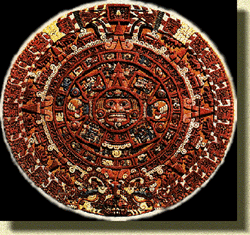|
| |
The Great Aztec Sun Stone

Aztec Sun Stone
Among the few important relics which had survived from
the Aztec empire, one of great interest was discovered
by accident in 1790. When the viceroy had ordered repairs
to the paving of the great Plaza Mayor to improve the
drainage in the front of the cathedral, workmen had struck a
large stone below the surface, almost in front of the
viceroy's palace. The Stone, a solid piece of gray-black
basalt, measured twelve feet across and was almost three
feet thick, and weighed about twenty-four tons.
It's presence was explained by the fact that when
Cortez dismantled the great city of Tenochtitlan he
ordered all large statues and stonework too solid to be
broken up to be buried so that no remnant of the great
Aztec capital be left to remind the Aztecs of their former
glory. The clergy also consider the sun stone a "sacrificial
altar," and wanted to bury with the stone, "the memory
of the detestable acts perpetrated on it."
There lived in Mexico City in 1790 a historian named
Antonio de Leon y Gama who had spent a lifetime studying
ancient documents and had mastered the Nahuatl language and
learned to interpret some of its hieroglyphs. Antonio de
Leon y Gama, then in his fifties, recognized the stone as
the famous Aztec calendar, of which Siguenza had written of.
To Leon y Gama the discovery of the calendar proved
beyond a doubt, that the pre-conquest indians had possessed
an advanced and remarkable knowledge of mathematics and
astronomy. Which they used to make accurate observations of
the movement of the suns, planets, and stars to produce a
calendar with 52 cycles each with 365 days, each divided
in 18 months with 20 days in each month, where they added 5
days on regular years and 6 days on leap years.
In a monograph explaining the sun stone, Leon y Gama
tried to show how falsely the ancient Mexicans had been
described as "irrational and simpleminded beings."
His explanation was too embarrassing for the Spanish
clergy. Without elementary notions of astronomy, they
continued to insist that the "calendar stone was a
sacrificial altar," arguing that the very fact that
"intertwined recurrent cycles were put together in such a
complex and aesthetic manner meant they were ornamental,
using as evidence the fact that the same symbols appeared on
earrings, necklaces and other purely decorative objects."
Leon y Gama pointed out, clearly and for the first time,
that the Aztec and the European calendars are responses to
very different concepts. This insight meant that he
frequently hit the mark, despite occasional errors in his
hypothesis, which were corrected throughout the course of
the nineteenth century by later archaeologists.

Leon y Gama recognized the great Aztec stone as a
sophisticated calendar. He believed its central cloverleaf
design represented the legendary Aztec epochs of the
four suns. In the third circle he recognized the twenty
Aztecs symbols for the days of the month and the hieroglyph
for four-ocelot, the day when the sun stood at the zenith
over Mexico City. As for the two enormous snakes around
the outer edge, Leon y Gama believed they represented the
Milky Way.
In the center of the Stone of the Sun is the face of
The sun, called Tonatiuh, was invoked by the names of
"the shining one," "the beautiful child,"" the eagle that
soars." At the sides appear his hands, tipped with eagle
claws clutching human hearts, for the sun was looked upon
by the Aztecs as an eagle. In the morning, as he rose into
the sky, he was called Cuauhtlehuanitl, "the eagle who
ascends." In the evening he was called Cuauhtemoc, "the
eagle who fell," the name of the last, unfortunate, heroic
Aztec emperor.
Around the figure of Tonatiuh there are sculptured in
large dimensions are the symbols of the Aztecs four-epochs.
On the top right the Jaguar Sun (Ocelotonatiuh) symbolized
the first of earth's four epochs. It was believed that this
era the world was inhabited by giants that were devoured by
jaguars. The jaguar is adorned with a "smoking mirror," the
symbol of the god Tezcatlipoca. On the top left the Wind
God (Ehecatonatiuh) symbolized the second era. At it's end
humanity was destroyed by hurricanes and the survivors
transformed into monkeys. The God of this era is
Quetzalcoatl. The third era on the lower left of the center
is the Rain(Sun-Quiauhtonatiuh). Tlaloc the god of rain and
celestial fire reigned over this period. It was believed
that humanity was then destroyed by a rain of fire. The men
who survived were converted into birds. On the lower right
on the center is the forth epoch, represented by the Water
God-Atonatiuh. At the end of this era it was believed that
Humanity was exterminated by a flood and the survivors
turned into fish. This epoch is represented by a vessel of
water, and the goddess Chalchiuhtlicue.
The Aztec Stone of the Sun is now the showpiece in the
Mexica room of the Museo de Antropologia in Mexico City.
the Stone of Sun has become a national symbol of Mexico.
Archeologist Zelia Nullal described the Stone of the
Sun as "the most precious and remarkable monument ever
unearthed on the American Continent," and "one of most
admirable and perfect achievements of the human intellect."
written by Sal Rojas
|
|
|
|




